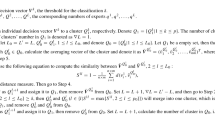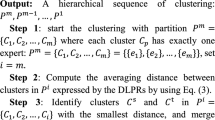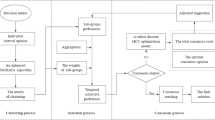Abstract
Nowadays, the increasing complexity of the social environment brings much difficulty in group decision making. The more uncertainty exists in a decision-making problem, the more collective wisdom is needed. Therefore, large scale group decision making has attracted a lot of researchers to investigate. Since the probabilistic linguistic terms have impressive performance in expressing DMs’ opinions, this paper proposes a novel method for large scale group decision making with probabilistic linguistic preference relations. More specifically, (1) a probability k-means clustering algorithm is introduced to segment DMs with similar features into different sub-groups; (2) an integration method is proposed to construct the collective probabilistic preference relation that retains initial information to the most extent; (3) taking the personality of each DM into account, a consensus model is constructed to improve the rationality and efficiency of consensus reaching process. Several simulation experiments are designed to analyze the influence factor in the feedback mechanism and make some comparative analysis with the existing method. Finally, an illustrative example of contractor selection is conducted to verify the validity of the proposed method.





Similar content being viewed by others
References
Lehrer K, Wagner C (1981) Rational consensus in science and society: a philosophical and mathematical study. Kluwer Academic, Boston
Saint S, James L (1994) Rules for reaching consensus: a modern approach to decision making. Pfeiffer & Company, San Diego
Kacprzyk J, Nurmi H, Fedrizzi M (1997) Consensus under fuzziness. Kluwer Academic, Boston
Alonso S, Pérez IJ, Cabrerizo FJ, Herrera-Viedma E (2013) A linguistic consensus model for Web 2.0 communities. Appl Soft Comput 13:149–157
Parreiras RO, Ya Ekel P, Martini JSC, Palhares RM (2010) A flexible consensus scheme for multicriteria group decision making under linguistic assessments. Inf Sci 180:1075–1089
Palomares I, Martinez L (2014) A semisupervised multiagent system model to support consensus-reaching processes. IEEE Trans Fuzzy Syst 22:762–777
Morente-Molinera JA, Wu X, Morfeq A, Al-Hmouz R, Herrera-Viedma E (2020) A novel multi-criteria group decision-making method for heterogeneous and dynamic contexts using multi-granular fuzzy linguistic modelling and consensus measures. Inf Fusion 53:240–250
Buyukozkan G (2004) Multi-criteria decision making for e-marketplace selection. Internet Res-Electron Netw Appl Policy 14:139–154
Kim J (2008) A model and case for supporting participatory public decision making in e-democracy. Group Decis Negot 17:179–193
Sueur C, Deneubourg JL, Petit O (2012) From social network (centralized vs. decentralized) to collective decision-making (unshared vs. shared consensus). PLoS ONE 7:10
Ureña R, Kou G, Dong YC, Chiclana F, Herrera-Viedma E (2019) A review on trust propagation and opinion dynamics in social networks and group decision making frameworks. Inf Sci 478:461–475
Palomares I, Martinez L, Herrera F (2014) A consensus model to detect and manage noncooperative behaviors in large-scale group decision making. IEEE Trans Fuzzy Syst 22:516–530
Labella A, Liu Y, Rodriguez RM, Martinez L (2018) Analyzing the performance of classical consensus models in large scale group decision making: a comparative study. Appl Soft Comput 67:677–690
Tang M, Zhou XY, Liao HC, Xu JP, Fujita H, Herrera F (2019) Ordinal consensus measure with objective threshold for heterogeneous large-scale group decision making. Knowl-Based Syst 180:62–74
Quesada FJ, Palomares I, Martinez L (2015) Managing experts behavior in large-scale consensus reaching processes with uninorm aggregation operators. Appl Soft Comput 35:873–887
Ding RX, Wang XQ, Shang K (2019) F, Herrera, Social network analysis-based conflict relationship investigation and conflict degree-based consensus reaching process for large scale decision making using sparse representation. Inf Fusion 50:251–272
Chen XH, Liu R (2006) Improved clustering algorithm and its application in complex huge group decision-making. Syst Eng Electron 28:1695–1699
Liu X, Xu YJ, Montes R, Ding RX, Herrera F (2019) Alternative ranking-based clustering and reliability index-based consensus reaching process for hesitant fuzzy large scale group decision making. IEEE Trans Fuzzy Syst 27:159–171
Orlovski SA (1978) Decision-making with a fuzzy preference relation. Fuzzy Sets Syst 1:155–167
Saaty TL (1980) The analytic hierarchy process. McGraw-Hill, New York
Chiclana F, Herrera F, Herrera-Viedma E (1998) Integrating three representation models in fuzzy multipurpose decision making based on fuzzy preference relations. Fuzzy Sets Syst 97:33–48
Berredo RC, Ekel PY, Palhares RM (2005) Fuzzy preference relations in models of decision making. Nonlinear Anal 63:735–741
Xia MM, Xu ZS (2013) 2013. Managing hesitant information in GDM problems under fuzzy and multiplicative preference relations. Int J Uncertain Fuzz Knowl-Based Syst 21:865
Van Laarhoven PJM, Pedrycz W (1983) A fuzzy extension of Saaty’s priority theory. Fuzzy Sets Syst 11:229–241
Xu ZS (2002) A method for priorities of triangular fuzzy number complementary judgement matrices. Fuzzy Syst Math 16:47–50
Wang ZJ, Tong X (2016) Consistency analysis and group decision making based on triangular fuzzy additive reciprocal preference relations. Inf Sci 361–362:29–47
Szmidt E, Kacprzyk J (2002) Using intuitionistic fuzzy sets in group decision making. Control Cybern 31:1037–1053
Dong YC, Li CC, Herrera F (2015) An optimization-based approach to adjusting unbalanced linguistic preference relations to obtain a required consistency level. Inf Sci 292:27–38
Wu J, Chiclana F, Herrera-Viedma E (2015) Trust based consensus model for social network in an incomplete linguistic information context. Appl Soft Comput 35:827–839
Zadeh L (1965) Fuzzy sets. Inf Control 8:338–353
Rodriguez RM, Martinez L, Herrera F (2012) Hesitant fuzzy linguistic term sets for decision making. IEEE Trans Fuzzy Syst 20:109–119
Wang H, Xu ZS, Zeng XJ (2018) Hesitant fuzzy linguistic term sets for linguistic decision making: current developments, issues and challenges. Inf Fusion 43:1–12
Wei CP, Rodriguez RM, Martinez L (2018) Uncertainty measures of extended hesitant fuzzy linguistic term sets. IEEE Trans Fuzzy Syst 26:1763–1768
Ma ZZ, Zhu JJ, Ponnambalam K, Zhang ST (2019) A clustering method for large-scale group decision-making with multi-stage hesitant fuzzy linguistic terms. Inf Fusion 50:231–250
Wu ZB, Xu JP (2018) A consensus model for large-scale group decision making with hesitant fuzzy information and changeable clusters. Inf Fusion 41:217–231
Pang Q, Wang H, Xu ZS (2016) Probabilistic linguistic linguistic term sets in multi-attribute group decision making. Inf Sci 369:128–143
Zhang YX, Xu ZS, Wang H, Liao HC (2016) Consistency-based risk assessment with probabilistic linguistic preference relation. Appl Soft Comput 49:817–833
Zhang YX, Xu ZS, Liao HC (2017) A consensus process for group decision making with probabilistic linguistic preference relations. Inf Sci 414:260–275
Luo SZ, Zhang HY, Wang JQ, Lin L (2019) Group decision-making approach for evaluating the sustainability of constructed wetlands with probabilistic linguistic preference relations. J Oper Res Soc 70(12):2039–2055
Liu AJ, Qiu HW, Lu H, Guo XR (2019) A consensus model of probabilistic linguistic preference relations in group decision making based on feedback mechanism. IEEE Access 7:148231–148244
Gao HX, Ju YB, Santibanez Gonzalez DR, Ernesto WKZ (2020) Green supplier selection in electronics manufacturing: an approach based on consensus decision making. J Clean Prod 245:118781
Wang H, Xu ZS (2016) Interactive algorithms for improving incomplete linguistic preference relations based on consistency measures. Appl Soft Comput 42:66–79
Li CC, Dong YC, Herrera F (2019) A Consensus model for large-scale linguistic Group decision making with a feedback recommendation based on clustered personalized individual semantics and opposing consensus groups. IEEE Trans Fuzzy Syst 27:221–233
Wu T, Liu XW (2016) An interval type-2 fuzzy clustering solution for large-scale multiple-criteria group decision-making problems. Knowl-Based Syst 114:118–127
Ureña R, Cabrerizo FJ, Morente-Molinera JA, Herrera-Viedma E (2016) GDM-R: a new framework in R to support fuzzy group decision making processes. Inf Sci 357:161–181
Liao HC, Xu ZS, Zeng XJ, Xu DL (2016) An enhanced consensus reaching process in group decision making with intuitionistic fuzzy preference relations. Inf Sci 329:274–286
Yu SM, Du ZJ, Xu XH (2020) Hierarchical punishment-driven consensus model for probabilistic linguistic large-group decision making with application to global supplier selection. Group Decis Negot 2:1–30
Acknowledgements
This work was funded by the National Natural Science Foundation of China (Nos. 71532007, 71771155).
Author information
Authors and Affiliations
Corresponding author
Additional information
Publisher's Note
Springer Nature remains neutral with regard to jurisdictional claims in published maps and institutional affiliations.
Rights and permissions
About this article
Cite this article
Liu, Q., Wu, H. & Xu, Z. Consensus model based on probability K-means clustering algorithm for large scale group decision making. Int. J. Mach. Learn. & Cyber. 12, 1609–1626 (2021). https://doi.org/10.1007/s13042-020-01258-5
Received:
Accepted:
Published:
Issue Date:
DOI: https://doi.org/10.1007/s13042-020-01258-5




